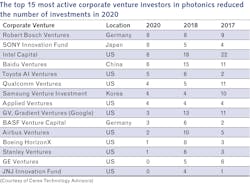Photonics in the transformative age: Radical collision of industries amidst a global pandemic
Linda Smith shared an investor’s views on the photonics business. Looking at the influence of the pandemic, she found that this crisis is accelerating the transformation in several major industries, which in turn leads to a faster adoption of photonics technologies. Thus, the interest of investors in photonics companies is rising.
“The total annual investment in pure-play photonics companies tripled since 2018 and the total annual investment in companies employing photonics globally more than doubled since 2018,” she said. Beside this positive trend, merger and acquisition (M&A) activities were severely stalled last year and fell from $191 billion in 2019 to $94 billion for announced M&A transactions in worldwide photonics in 2020. Smith expects a quick recovery of M&A markets in 2021 (see table).
To explain what transformation means to markets, she analyzed three industries: supply chain, food, and health. Amazon was the example for revolutionizing the supply chain. Originally a marketplace for consumer goods, Amazon is now the largest B2B and B2C retailer of goods and services in the world. It leads across all sectors with a highly scalable logistics platform. Still, this logistics giant is relying on further technological progress, which is a great opportunity for photonics. Through mobility technology, industrial automation, AR/VR, communications, and computing, photonics is solving problems that IT and logistics cannot solve alone.
One key technology that leads to severe progress in logistics and automotive is what Smith called mobility technology. This comprises technologies that enable unmanned aerial vehicles (UAVs), unmanned ground vehicles (UGVs), or smart robots. Just for these three fields, she sees markets valued at $59 billion.
Lidar is key mobility technology and investments in it reached surprising heights in the past few months. Using special-purpose acquisition companies (SPACs), several lidar companies have gone public. Velodyne began publicly trading with a Graf Industrial SPAC at the end of 2020; its market capital was $4 billion. Luminar, with strategic investments from Volvo and Daimler, entered the public markets with SPAC Gores Metropoulos at the end of 2020; its market capitalization was $11 billion. Porsche-backed lidar startup AEVA announced it would merge with InterPrivate Acquisition Corp. at $2.1 billion post-deal market valuation. These are spectacular valuations rarely seen for photonics-based startups before.
Besides the growing investment opportunities on the technological side, Smith also discussed investments on the global scale, and particularly in China. China trounces the U.S. and Europe in volume and value of publicly reported investments in photonics companies in China in 2020, and this is expected to continue well into 2021. In recent years, the U.S. administration enacted a number of restrictions for investments, in particular through the Committee on Foreign Investment in the United States (CFIUS) legislation. The Biden administration is saying that it will continue with the CFIUS regulations being tough on China. Through CFIUS and the Foreign Investment Risk Review Modernization Act (FIRRMA), effective Nov 10, 2018, foreign investments in the U.S. will be slowed or completely blocked.
CONTINUE READING >>>

Andreas Thoss | Contributing Editor, Germany
Andreas Thoss is the Managing Director of THOSS Media (Berlin) and has many years of experience in photonics-related research, publishing, marketing, and public relations. He worked with John Wiley & Sons until 2010, when he founded THOSS Media. In 2012, he founded the scientific journal Advanced Optical Technologies. His university research focused on ultrashort and ultra-intense laser pulses, and he holds several patents.
